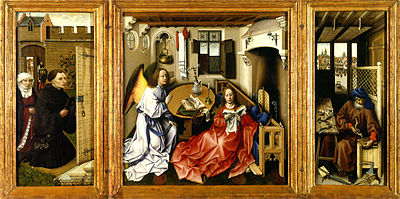- Robert Campin
-
Robert Campin (c. 1375 – 26 April 1444), now usually identified as the artist known as the Master of Flémalle, is usually considered the first great master of Early Netherlandish painting. This had been a matter of controversy for decades; Campin's life is relatively well documented for the period,[1] but no works in assessable condition could be securely connected with him, whilst a corpus of work had been attached to the unidentified "Master of Flémalle", named after the supposed origin of a work.[2]
Contents
Life
Campin seems to have had relatives in Valenciennes. He first appears as settled in Tournai from the archives of 1405-6, as a free master of the guild of painters, and he bought citizenship in 1410, which suggests he was not born there. He eventually attained the office of dean of the guild, and wardenship of a church and other civic offices, and was running a large workshop. By 1432, however, he lost his civic positions because of scandals, and probably his role in political disturbances in the city. In 1429 he was found guilty of withholding evidence, and sentenced to go on a pilgrimage, and in 1432 was convicted of adultery and banished for a year. Margaret of Burgundy, wife of the Count of Holland and sister of John the Fearless, Duke of Burgundy intervened on his behalf, and this was reduced to a fine.[3] The dated Werl Altarpiece (1438) shows he continued to work (the two outer wings are in the Prado; the main panel is lost).
Identity and style
Although heavily indebted to contemporary masters of manuscript illumination, Campin displayed greater powers of realistic observation than any other painter before him. He was one of the first artists to experiment with the use of oil-based colors, in lieu of egg-based tempera, to achieve the brilliance of color typical for this period. Campin used the new technique to convey strong, rounded characters by modelling light and shade in compositions of complex perspectives. It remains a matter of debate how far the complex symbolism that is generally accepted as existing in the work of Van Eyck also exists in the work of Campin.
Art historians have long been keen to trace the beginnings of the Northern Renaissance - with far less evidence to go on than in Italy. For a long time it was thought that Jan van Eyck was the first painter to make full use of the innovations apparent in manuscript illumination in panel painting.
By the end of the 19th century it became clear, however, that Van Eyck was the contemporary of an artist who painted a number of works, including the Mérode Altarpiece. Dated to about 1428, the altarpiece (now in the Cloisters of the Metropolitan Museum) is permeated with loving attention to details and realism. Three other panels in a similar manner, supposed to come from the so-called abbey of Flémalle (it has been established that there was, in fact, no such abbey), are now in Frankfurt. It was argued that these works belong to one "Master of Flémalle", whose identity at that time could not be established.
In the 20th century, several scholars suggested that the Master of Flémalle may be none other than Robert Campin, documented as a master painter in Tournai from 1406. The argument turns around a paper mentioning two pupils entering his studio in 1427 - Jacques Daret and Rogelet de la Pasture. The latter was probably Rogier van der Weyden. A very well-documented altarpiece by Daret shows striking similarities with the works of Master of Flémalle, as do early works by Rogier. Therefore it is tempting to assume that both Daret and Rogier were disciples of the Master of Flémalle, i.e. Robert Campin. Another possibility, however, is that the Flémalle panels were painted by Rogier himself when he was still in his twenties. Some scholars have even attributed the famous Deposition in the Prado (Madrid) to Campin rather than Van der Weyden.
The tightest definition of the works from his own hand includes only the "Flémalle" panels, a Nativity at Dijon, a Crucified Thief (fragment of a Crucifixion) in Frankfurt, two portraits of a man and woman in London (of around 1430), and perhaps the Seilern Triptych. This, which excludes the best known works usually attributed to him, which are given to his workshop or followers, is the position taken by Lorne Campbell.[4]
Work
The Entombment Triptych (or "Seilern Triptych" Courtauld Institute, London) is usually considered Campin's earliest work, dated to around 1415-20.[5] The central panel shows his debt to the sculpture of the time (Campin was known to have polychromed several statues). After this, he painted the Marriage of the Virgin (Museo del Prado, Madrid) and Nativity (Musée des Beaux-Arts de Dijon) around 1420-1425.
Around 1425-1428 Campin painted the Mérode Altarpiece, a triptych (three paneled paintings) commissioned for private use. The Annunciation occupies the central panel. The Archangel Gabriel is shown approaching Mary, who sits reading. She is depicted in a well-kept middle-class Flemish home. Several works attributed to Robert Campin may be seen in the Hermitage, Prado, and the National Gallery (London).
Notes
- ^ Campbell, Lorne. "Robert Campin, the Master of Flémalle and the Master of Mérode ". The Burlington Magazine, Volume 116, No. 860, Nov. 1974. 634-646
- ^ Fragments remain probably from some wall-paintings for which he was paid in 1406-7 Campbell:72
- ^ Campbell op cit:72, and Campbell 1974
- ^ Campbell:72
- ^ Courtauldimages.com
References
- National Gallery Catalogues (new series): The Fifteenth Century Netherlandish Paintings, Lorne Campbell, 1998, ISBN 185709171X
External links
Categories:- 1370s births
- 1444 deaths
- Early Netherlandish painters
- Members of the Tournai Guild of Saint Luke
Wikimedia Foundation. 2010.



